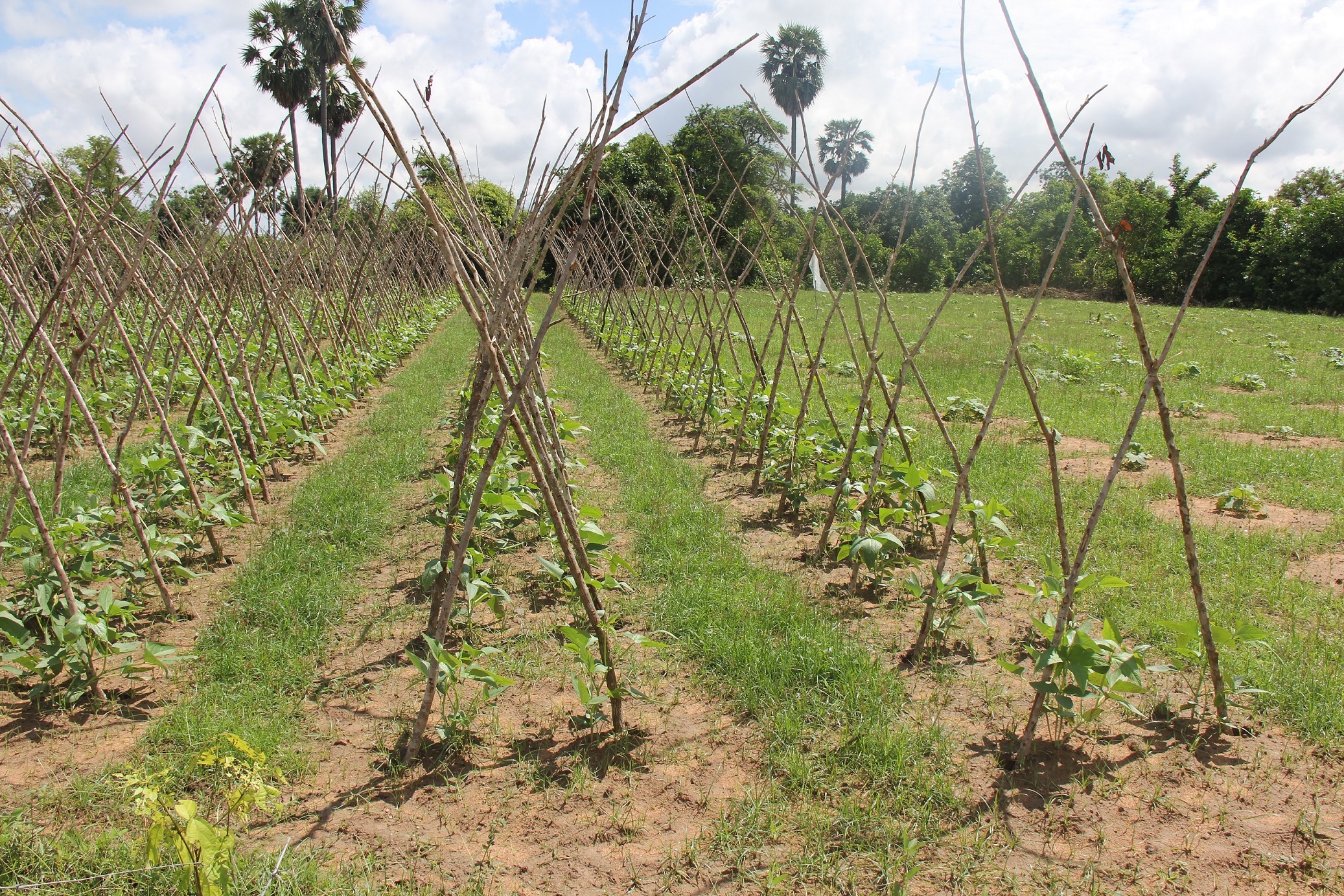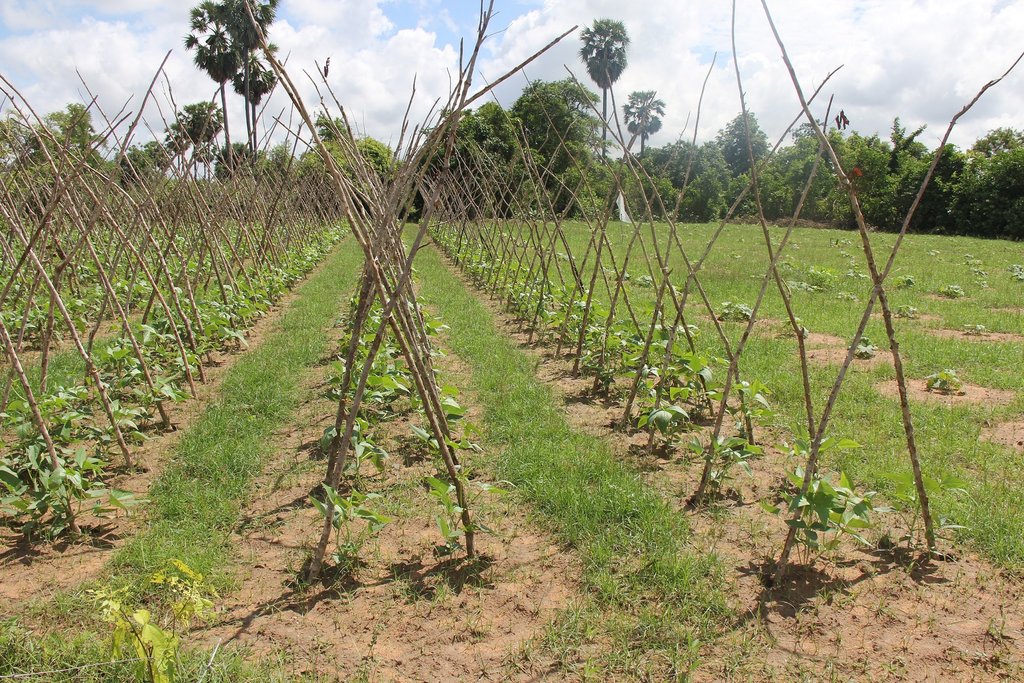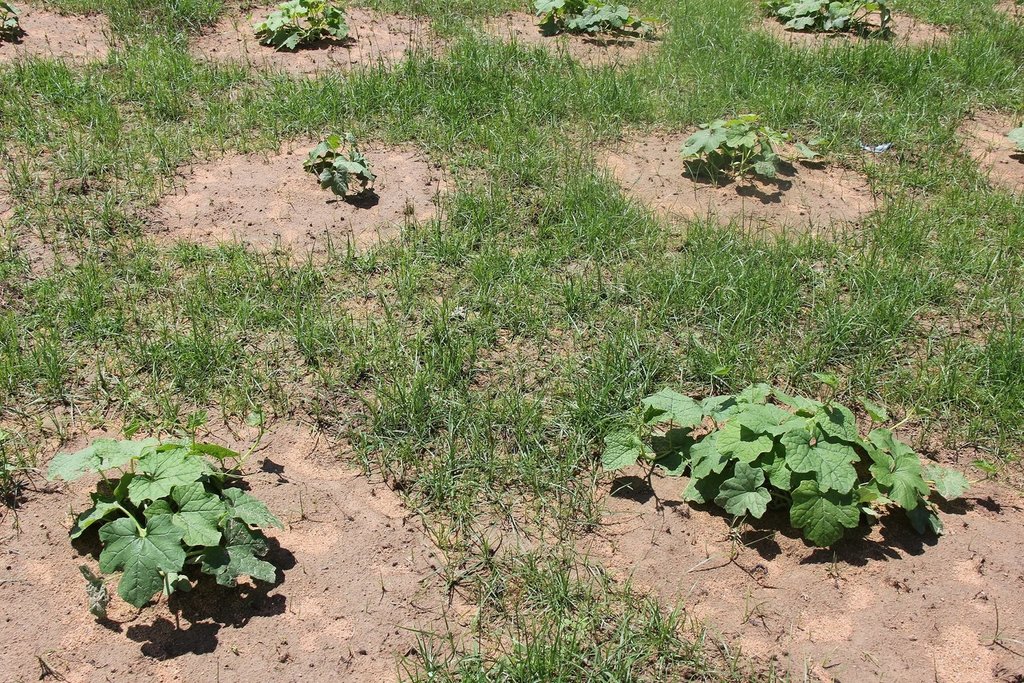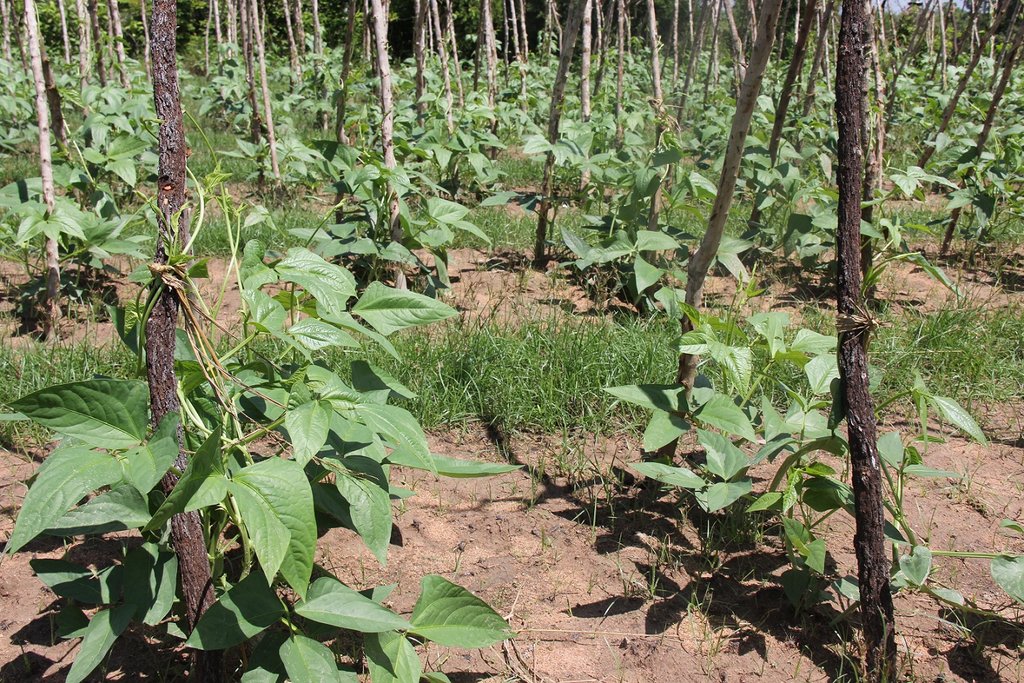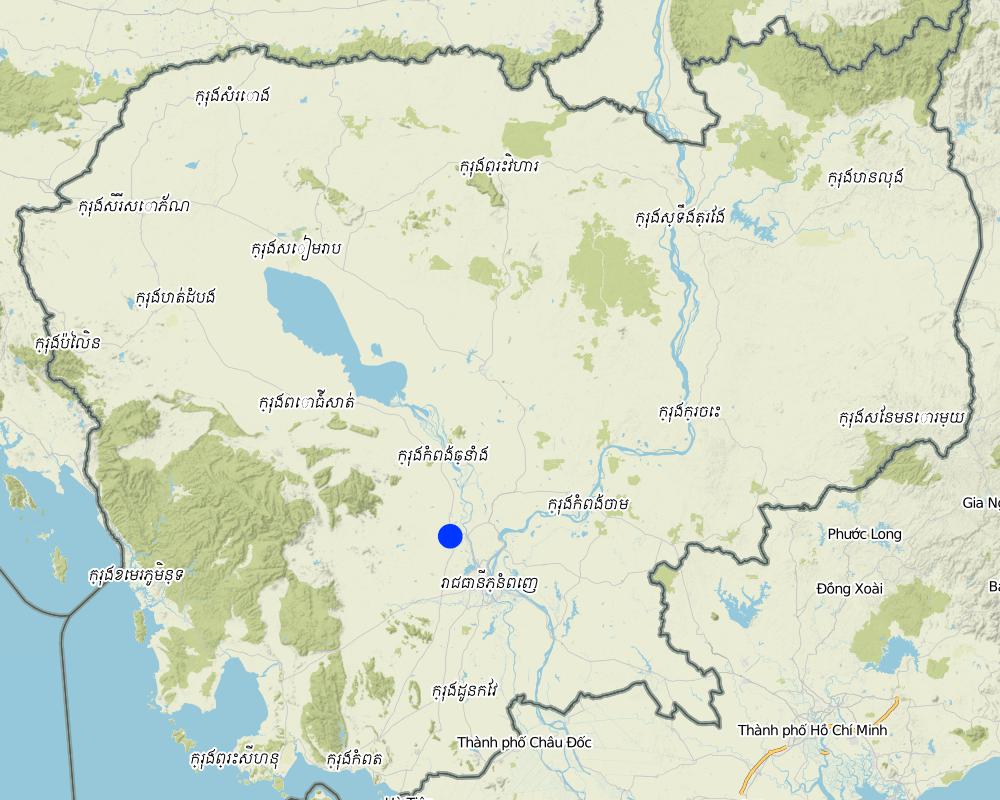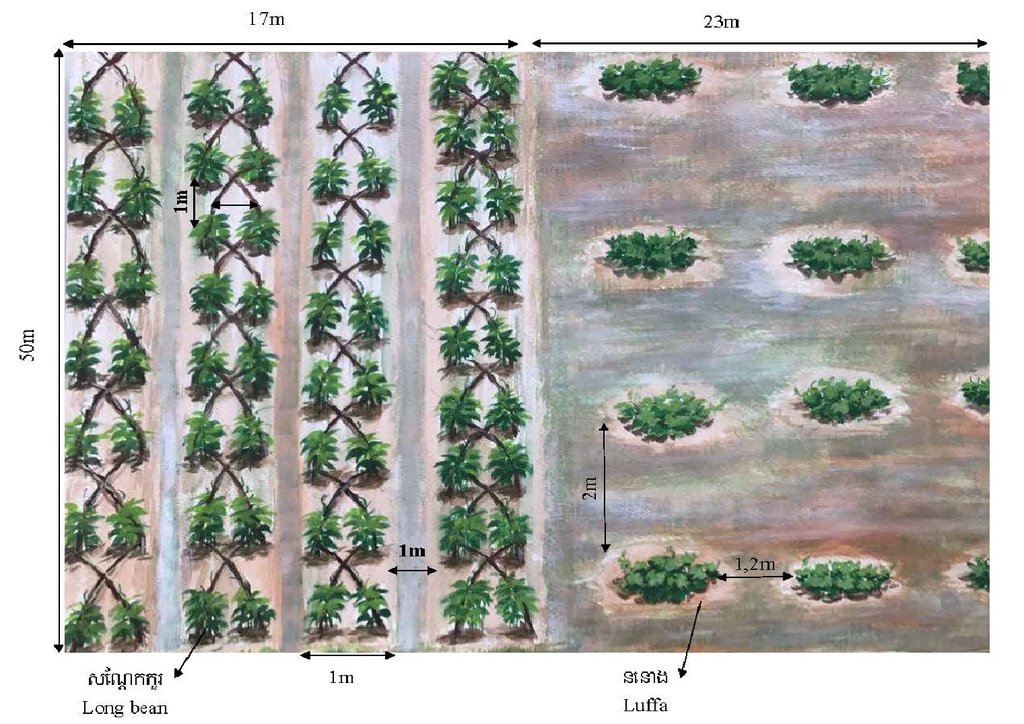ការអនុវត្តដំណាំវិលជុំដើម្បីលើកកម្ពស់បន្លែសុវត្ថិភាព [Cambodia]
- Creation:
- Update:
- Compiler: Be Gechkim
- Editors: Navin Chea, Sophea Tim
- Reviewers: Nicole Harari, SO Than, Alexandra Gavilano
បន្លែសុវត្ថិភាព
technologies_3165 - Cambodia
View sections
Expand all Collapse all1. معلومات عامة
1.2 Contact details of resource persons and institutions involved in the assessment and documentation of the Technology
Key resource person(s)
land user:
ចន្ធូ ឯក
កសិករ
Cambodia
អនុប្រធានការិយាល័យផ្សព្វផ្សាយកសិកម្មនៅមន្ទីរកសិកម្ម រុក្ខាប្រមាញ់ និងនេសាទ ខេត្តកំពង់ឆ្នាំង:
ប្រធានការិយាល័យកសិកម្មស្រុកទឹកផុស:
អនុប្រធានផ្នែកក្សេត្រសាស្ត្រនៅការិយាល័យកសិកម្មស្រុករលៀប្អៀរ:
ប៊ុនលៀង ឈឹម
ការិយាល័យកសិកម្មស្រុករលៀប្អៀរ
Cambodia
Name of project which facilitated the documentation/ evaluation of the Technology (if relevant)
Scaling-up SLM practices by smallholder farmers (IFAD)Name of the institution(s) which facilitated the documentation/ evaluation of the Technology (if relevant)
Royal University of Agriculture (RUA) - Cambodia1.3 Conditions regarding the use of data documented through WOCAT
The compiler and key resource person(s) accept the conditions regarding the use of data documented through WOCAT:
نعم
1.4 Declaration on sustainability of the described Technology
Is the Technology described here problematic with regard to land degradation, so that it cannot be declared a sustainable land management technology?
لا
Comments:
កសិករដំាដំណាំផ្លាស់ប្ដូរប្រភេទ និងប្ដូរទិសដៅរងដំណាំផងដែរ។
1.5 Reference to Questionnaire(s) on SLM Approaches (documented using WOCAT)
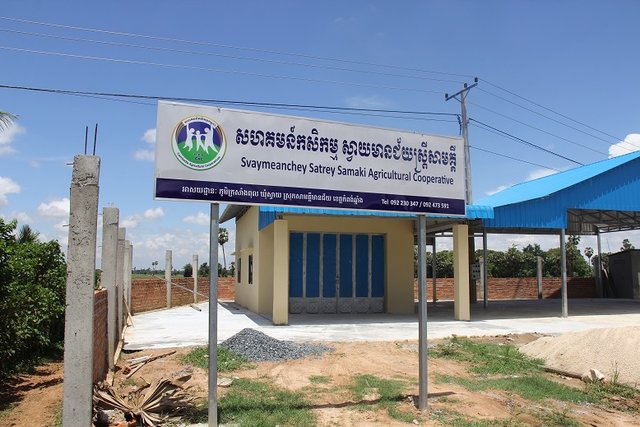
ក្រុមកសិករផលិតបន្លែសុវត្ថិភាពនៅក្នុងសហគមន៍កសិកម្ម ស្វាយមានជ័យស្ត្រីសាមគ្គី [Cambodia]
ការចងក្រងក្រុមកសិករដាំបន្លែសុវត្ថិភាពត្រូវបានបង្កើតឡើងតាមគោលការណ៍ស្ម័គ្រចិត្ត និង វាជាផ្នែកមួយនៃសហគមន៍កសិកម្ម (AC)។ ក្រុមនេះ គឺគាំទ្រទៅដល់ការលក់ផលិតផល តាមរយៈការប្រមូលផ្តុំបង្កើតជាក្រុមឡើងសម្រាប់អ្នកទិញ។ អ្នកផលិត និងអ្នកទិញបាន ចុះកិច្ចសន្យាដែលជាលក្ខខណ្ឌជាចម្បង និងកិច្ចយល់ព្រមព្រៀងគ្នា។ លក្ខខណ្ឌជាចម្បង គឺត្រូវដាំដុះដោយប្រើប្រាស់ជីគីមី និងថ្នាំពុលកសិកម្មតាមកម្រិតស្តង់ដារ ដើម្បីធានាសុវត្ថិភាពដល់អ្នកផលិត និងអ្នកប្រើប្រាស់។
- Compiler: Navin Chea
2. Description of the SLM Technology
2.1 Short description of the Technology
Definition of the Technology:
ដំណាំវិលជុំ គឺជាបច្ចេកទេសមួយនៅក្នុងវិធានការចម្រុះការពារដំណាំ (IPM) ដើម្បីរួមចំណែកបង្កើនផលិតផល ដោយប្រើប្រាស់ក្នុងកម្រិតស្តង់ដារមួយ និងកាត់បន្ថយការប្រើប្រាស់ជីគីមី និងថ្នាំពុលកសិកម្ម។
2.2 Detailed description of the Technology
Description:
ដំណាំវិលជុំ គឺជារបៀបអនុវត្តការងារដាំដុះដោយឆ្លាស់ប្រភេទមុខដំណាំខុសៗគ្នាលើផ្ទៃដីដដែលតែមួយ តាមរដូវដាំដុះបន្តបន្ទាប់គ្នា។ ផលប្រយោជន៍ដែលទទួលបានពីការអនុវត្តនេះ គឺសារធាតុចិញ្ចឹម និងអាសូតនឹងផ្តល់ដល់ដីដាំដុះ តាមការប្រើប្រាស់ជីស្រស់ ដែលធ្វើបែបនេះ គឺដូចទៅនឹងប្រពៃណីដែលធ្លាប់មាន ក្នុងការដំណាំផ្សេងៗឆ្លាស់ជាមួយនឹងធញ្ញជាតិ។ ការដាំដំណាំវិលជុំអាចកាត់បន្ថយការកកើតជំងឺ និងសត្វល្អិតដែលតែងតែកើតមានឡើងនៅពេលដែលបន្តដាំដំណាំដដែលៗក្នុងរយៈពេលយូរ ហើយដំណាំវិលជុំក៏អាចធ្វើឱ្យកាន់តែប្រសើរនូវរចនាសម្ព័ន្ធ និងជីជាតិដីដោយការស្រូបយកជីជាតិដីខុសៗគ្នា និងប្រព័ន្ធឫសដែលអាចចាក់ចូលទៅក្នុងជម្រៅដីខុសៗគ្នាផងដែរ (Cotheren J., 2014)។ ថ្វីត្បិតតែនៅប្រទេសកម្ពុជាមានច្បាប់ស្តីពីការគ្រប់គ្រងថ្នាំកសិកម្ម និងជីកសិកម្មក៏ពិតមែន តែកសិករមួយចំនួននៅតែប្រើប្រាស់ថ្នាំ និងជីកសិកម្មមិនទាន់សមស្របនៅឡើយ ដូច្នេះការដាំដំណាំបង្វិល គឺជាបច្ចេកទេសមួយដែលជួយកសិករក្នុងការបង្កើនទិន្នផល និងកាត់បន្ថយសត្វល្អិតបំផ្លាញដំណាំ រក្សា និងបង្កើនជីជាតិដីតាមវិធានការក្សេត្រសាស្ត្រ និងជីវសាស្ត្រ។
លោកស្រី ឯក ចន្ធូរបានជ្រើសរើសការដាំបន្លែជាលក្ខណៈវិលជុំពេញមួយឆ្នាំ រួមផ្សំជាមួយការកាត់បន្ថយការប្រើប្រាស់ ជីគីមី និងថ្នាំពុលកសិកម្មព្រោះវាអាចជួយកាត់បន្ថយចំណាយ។ គុណប្រយោជន៍សំខាន់មួយទៀតគឺគាត់បាន ចុះកិច្ចសន្យាលក់បន្លែឱ្យក្រុមហ៊ុនរ៉ីមិច (REMIC ភាពជាសហគ្រិន និងការដាក់បញ្ចូលទីផ្សារ ជនបទនៅកម្ពុជា) ដោយសារតែគាត់ជាសមាជិកក្នុងក្រុមផលិតបន្លែសុវត្ថិភាព។ បន្ថែមលើនេះទៅទៀតគាត់អាចលក់បន្លែដែលសល់ ទៅឱ្យឈ្មួញផ្សេងទៀតបន្ទាប់ពីបំពេញកិច្ចសន្យាលក់ឱ្យ ក្រុមហ៊ុនរ៉ីមិច គ្រប់ចំនួន។ ការជ្រើសរើសការដាំដុះបន្លែវិលជុំនេះអាចរក្សា និងបង្កើនជីជាតិដីដោយគ្រាន់តែបន្ថែមជីសរីរាង្គ និងជីពាក់កណ្តាលសរីរាង្គជំនួសឱ្យការប្រើប្រាស់ជីគីមី។ ដោយឡែកការប្រើប្រាស់ថ្នាំពុលកសិកម្មក៏ត្រូវបានកាត់បន្ថយដោយការឆ្លាស់មុខដំណាំជាប្រចាំផងដែរ។
ក្នុងករណីសិក្សានេះដំណាំវិលជុំរួមមានសណ្ដែកកួរ ននោង ត្រឡាច ល្ពៅ និងត្រសក់ជាដើម។ ការអនុវត្តបែបនេះ គឺដើម្បីរក្សាបានតុល្យភាពជីជាតិដី ដោយជៀសវាងដំណាំដដែលនឹងស្រូបយកជីជាតិដដែលៗជាហេតុនាំឱ្យដីរេចរឹល ជីជាតិ។ ម្យ៉ាងវិញទៀតការដាំដុះដំណាំវិលជុំក៏រួមចំណែកកាត់បន្ថយការកើតឡើងនូវជំងឺ និងការកើនឡើងនៃសត្វល្អិត ចង្រៃ ដោយមុខដំណាំដដែលៗនឹងជាក្លាយជាជម្រកសម្រាប់ភ្នាក់ងារចម្លងជំងឺដែលរស់នៅក្នុងដី។ ក្នុងការដាំដុះជាក់ស្តែង កសិករម្នាក់ៗត្រូវដាំដំណាំចំនួន ២ ឬ ៣ ប្រភេទ នៅក្នុងពេលតែមួយ ហើយត្រូវបង្វិលដាំដំណាំផ្សេងវិញក្នុងរដូវកាលបន្ទាប់។ ទោះជាយ៉ាងនេះក្តី ក៏នៅតែមានការសម្របសម្រួលពី ក្រុមហ៊ុនរ៉ីមិច លើការជ្រើសរើសមុខដំណាំ ដើម្បីឱ្យកសិករម្នាក់ៗដាំដំណាំចម្រុះឆ្លាស់គ្នាតាមវេន សម្រាប់បំពេញតម្រូវការទីផ្សារ។
កសិកររូបនេះបានឱ្យដឹងថា មុនពេលអនុវត្តការដាំដំណាំវិលជុំ គាត់និយមដាំដំណាំតែមួយមុខ ឬពីរមុខដដែលៗរាល់រដូវកាល ព្រោះដំណាំនោះជាប្រភេទដំណាំដែលមានទីផ្សារហើយបានថ្លៃខ្ពស់ទៀតផង តែដើម្បីរក្សាបានទិន្នផល និងការពារការបំផ្លាញពីសត្វល្អិត គាត់ចាំបាច់ត្រូវប្រើជីគីមី និងថ្នាំកសិកម្មក្នុងបរិមាណច្រើន តែទោះជាយ៉ាងនេះក្តីប្រសិទ្ធភាពនៃជី និងថ្នាំគឺមានប្រសិទ្ធភាពតែក្នុងមួយរយៈពេលខ្លីតែប៉ុណ្ណោះ ជាហេតុធ្វើឱ្យមានការចំណាយកាន់តែច្រើនឡើងៗ។ ក្រោយពីទទួលបានការបណ្តុះបណ្តាលពីអង្គភាពជំនាញគឺ អង្គការអេកូ (ECHO អង្គការហៃទីទាក់ទងនឹងវិស័យអប់រំ) ក្រុមហ៊ុនភាពរ៉ីមិច និងមន្ទីរកសិកម្មខេត្ត បានធ្វើឱ្យមានការផ្លាស់ប្តូរពីការដាំដំណាំតែមួយមុខមកដាំជាលក្ខណៈវិលជុំ និងផ្លាស់ប្តូរពីជីគីមីមកជាជីសរីរាង្គ និងពាក់កណ្តាលសរីរាង្គ ហើយជាពិសេសការប្រើថ្នាំកសិកម្មក៏បានកាត់បន្ថយតាមកម្រិតកំណត់ផងដែរ។ ការអនុវត្តបែបនេះធ្វើឱ្យគុណភាពដីកើនឡើងជាលំដាប់ ជំងឺ និងសត្វល្អិតបំផ្លាញដំណាំក៏ថយចុះ កាត់បន្ថយចំណាយ បង្កើនចំណូល ហើយការពារសុខភាពអ្នកផលិត និងអ្នកប្រើប្រាស់បានទៀតផង។
ដោយកសិករកាន់តែមានជំនាញ ហើយការដាំដំណាំវិលជុំក៏មាននិរន្តរភាពទៀតនោះ ធ្វើឱ្យពួកគាត់អាចមាន លទ្ធភាពកាន់តែល្អប្រសើរក្នុងការផ្គត់ផ្គង់ទីផ្សារ។ ជាក់ស្តែងភាពជោគជ័យនៃការអនុវត្តក្នុងតំបន់នេះ គឺដោយសារមានការសម្របសម្រួលពីក្រុមហ៊ុនរ៉ីមិច ក្នុងការធ្វើផែនការផលិតកម្ម និងចុះកិច្ចសន្យា ដើម្បីធានាឱ្យមានផលិតផលបន្លែចម្រុះគ្រប់គ្រាន់សម្រាប់ការផ្គត់ផ្គង់ដល់ទីផ្សារ។ លើសពីនេះទៀតដោយមានការចូលរួមសហការត្រួតពិនិត្យលើការប្រើប្រាស់ជីគីមី និងថ្នាំពុលកសិកម្ម ពីអង្គការអេកូ ធ្វើឱ្យអតិថិជនកាន់តែមានទំនុកចិត្តខ្ពស់ ដោយធានាថាបន្លែដែលបានផ្គត់ផ្គង់ទៅកាន់ទីផ្សារគឺពិតជាបន្លែសុវត្ថិភាព ដែលនេះជាអាចឱកាសឱ្យកសិករលក់ផលិតផលរបស់ខ្លួនក្នុងតម្លៃមួយខ្ពស់ជាងបន្លែធម្មតា ។
2.3 Photos of the Technology
2.5 Country/ region/ locations where the Technology has been applied and which are covered by this assessment
بلد:
Cambodia
Region/ State/ Province:
ភូមិខ្យាងត្បូង ឃុំស្វាយ ស្រុកសាមគ្គីមានជ័យ ខេត្តកំពង់ឆ្នាំង
Specify the spread of the Technology:
- evenly spread over an area
If the Technology is evenly spread over an area, specify area covered (in km2):
0,002
If precise area is not known, indicate approximate area covered:
- < 0.1 km2 (10 ha)
Comments:
អនុវត្តលើផ្ទៃដី ៥០ x ៤០ ម៉ែត្រ = ២០០០ ម៉ែត្រការ៉េប៉ុណ្ណោះ
Map
×2.6 Date of implementation
Indicate year of implementation:
2016
2.7 Introduction of the Technology
Specify how the Technology was introduced:
- through projects/ external interventions
Comments (type of project, etc.):
អង្គការហៃទីទាក់ទងនឹងវិស័យអប់រំ (ECHO)
3. Classification of the SLM Technology
3.1 Main purpose(s) of the Technology
- reduce, prevent, restore land degradation
- create beneficial economic impact
3.2 Current land use type(s) where the Technology is applied

الأراضي الزراعية
- Annual cropping
Annual cropping - Specify crops:
- vegetables - melon, pumpkin, squash or gourd
- legumes and pulses - beans
- ត្រសក់និងលីដា។
Annual cropping system:
Vegetables - wheat/barley/oat/upland rice
Number of growing seasons per year:
- 2
حددها:
ខែ៤ រឺ ៥ (សណ្ដែកកួរ ននោង ត្រឡាច) និង ខែ១១ រឺ ១២ (ត្រសក់ ត្រឡាច ឯសណ្ដែកកួរច្រើនមានដង្កូវដូចនេះមិនត្រូវបានដាំទេ)។
Is crop rotation practiced?
نعم
If yes, specify:
ខែ៤ រឺ ៥ (សណ្ដែកកួរ ននោង ត្រឡាច) និង ខែ១១ រឺ ១២ (ត្រសក់ ត្រឡាច ឯសណ្ដែកកួរច្រើនមានដង្កូវដូចនេះមិនត្រូវបានដាំទេ)។
Comments:
សណ្ដែកកួរ ននោង ត្រសក់ ត្រឡាច
3.3 Has land use changed due to the implementation of the Technology?
Has land use changed due to the implementation of the Technology?
- Yes (Please fill out the questions below with regard to the land use before implementation of the Technology)

الأراضي الزراعية
Comments:
ដំាដំណាំប៉ុន្តែមិនមានដំណាំច្រើនមុខទេ ហើយក៏មិនបង្វិលមុខដំណាំនោះដែរ។
3.4 Water supply
Water supply for the land on which the Technology is applied:
- mixed rainfed-irrigated
3.5 SLM group to which the Technology belongs
- rotational systems (crop rotation, fallows, shifting cultivation)
- integrated soil fertility management
- integrated pest and disease management (incl. organic agriculture)
3.6 SLM measures comprising the Technology

agronomic measures
- A1: Vegetation/ soil cover
- A2: Organic matter/ soil fertility
3.7 Main types of land degradation addressed by the Technology
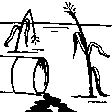
chemical soil deterioration
- Cn: fertility decline and reduced organic matter content (not caused by erosion)
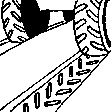
physical soil deterioration
- Pc: compaction
- Pu: loss of bio-productive function due to other activities

biological degradation
- Bq: quantity/ biomass decline
- Bp: increase of pests/ diseases, loss of predators
3.8 Prevention, reduction, or restoration of land degradation
Specify the goal of the Technology with regard to land degradation:
- prevent land degradation
- reduce land degradation
Comments:
រក្សាសារធាតុចិញ្ចឹមក្នុងដី និងកាត់បន្ថយជំងឺរបស់ដំណាំដោយដាំដំណាំបង្វិលជាមួយនឹងការប្រើប្រាស់ជីសរីរាង្គ និងពាក់កណ្តាលសរីរាង្គ។
4. Technical specifications, implementation activities, inputs, and costs
4.1 Technical drawing of the Technology
Technical specifications (related to technical drawing):
កសិករអនុវត្តបច្ចេកទេសនេះលើផ្ទៃដីសរុបដែលមានទំហំ ៥០ x ៤០ ម៉ែត្រ។ ផ្ទៃដីនេះចែកជាប្លុកដែលមានដាំសណ្ដែកកួរមានទំហំ ៥០ x ១៧ ម៉ែត្រមាន ៨ រង ដែលមានចន្លោះរង ១ ម៉ែត្រ។ រងនីមួយៗមាន ២ជួរដំណាំដែលមានចន្លោះ ០,៦ ម៉ែត្រ និងចន្លោះគុម្ព ១ ម៉ែត្រ។ នៅពេលដាំកសិករមិនលើករងទេដោយគ្រាន់តែជីករណ្តៅទំហំ ១៥ x ១៥ សង់ទីម៉ែត្រ និងជម្រៅ ១៥ សង់ទីម៉ែត្រ ហើយដាំដោយកប់គ្រាប់ក្នុងជម្រៅប្រហែល ៣ សង់ទីម៉ែត្រ។ ផ្ទៃដីដាំននោងមានទំហំបណ្តោយ ៥០ x ២៣ ម៉ែត្រ មាន ៩ រង ដែលមានចន្លោះគុម្ព ១,២ ម៉ែត្រ។ រីឯចន្លោះរងដំណាំ គឺ ២ ម៉ែត្រ ហើយជីករណ្តៅ និងការដាំដូចគ្នានឹងការដាំសណ្តែកកួរដែរ។
Author:
លោក ឃួន សុផល
Date:
25/05/2017
4.2 General information regarding the calculation of inputs and costs
Specify how costs and inputs were calculated:
- per Technology area
Indicate size and area unit:
៤០ x ៥០ ម = ២០០ ម៉ែត្រការ៉េ
other/ national currency (specify):
រៀល
If relevant, indicate exchange rate from USD to local currency (e.g. 1 USD = 79.9 Brazilian Real): 1 USD =:
4000,0
Indicate average wage cost of hired labour per day:
20000 រៀល
4.3 Establishment activities
| Activity | Timing (season) | |
|---|---|---|
| 1. | ភ្ជួរដីហាល | ខែមេសា |
| 2. | កាប់រណ្ដៅ | ខែមេសា |
| 3. | ដាក់ជីសរីរាង្គ និងលាមកគោ | ខែមេសា |
| 4. | ដាំគ្រាប់ | ខែមេសា |
| 5. | ទិញម៉ាស៊ីនបូមទឹក | ខែមេសា |
4.4 Costs and inputs needed for establishment
| Specify input | Unit | Quantity | Costs per Unit | Total costs per input | % of costs borne by land users | |
|---|---|---|---|---|---|---|
| Labour | ភ្ជួរដីហាល | នាក់/ថ្ងៃ | 1,0 | 20000,0 | 20000,0 | 100,0 |
| Labour | ដាក់ជីសរីរាង្គ និងលាមកគោ | នាក់/ថ្ងៃ | 1,0 | 20000,0 | 20000,0 | 100,0 |
| Labour | កាប់រណ្ដៅ និងដាំ | នាក់/ថ្ងៃ | 5,0 | 20000,0 | 100000,0 | 100,0 |
| Equipment | ម៉ាស៊ីនបូមទឹក | គ្រឿង | 1,0 | 1200000,0 | 1200000,0 | 100,0 |
| Equipment | គោយន្ត | គ្រឿង | 1,0 | 6000000,0 | 6000000,0 | 100,0 |
| Plant material | គ្រាប់សណ្ដែកកួរ | កញ្ចប់ | 4,0 | 8000,0 | 32000,0 | 100,0 |
| Plant material | គ្រាប់ននោង | កញ្ចប់ | 5,0 | 7000,0 | 35000,0 | 100,0 |
| Fertilizers and biocides | ជីសរីរាង្គ | បាវ | 1,0 | 130000,0 | 130000,0 | 100,0 |
| Fertilizers and biocides | ជីពាក់កណ្ដាលសរីរាង្គ | បាវ | 1,0 | 130000,0 | 130000,0 | 100,0 |
| Construction material | ចបកាប់ | ចប | 2,0 | 9000,0 | 18000,0 | 100,0 |
| Construction material | បង្គី | បង្គី | 2,0 | 6000,0 | 12000,0 | 100,0 |
| Construction material | ជ្រលុង | ដើម | 1000,0 | 250,0 | 250000,0 | 100,0 |
| Total costs for establishment of the Technology | 7947000,0 | |||||
| Total costs for establishment of the Technology in USD | 1986,75 | |||||
4.5 Maintenance/ recurrent activities
| Activity | Timing/ frequency | |
|---|---|---|
| 1. | ស្រោចទឹក | រាល់ថ្ងៃនៅខែប្រាំង 1សប្ដាហ៍ម្ដង/វស្សា |
| 2. | ធ្វើស្មៅ | 1សប្ដាហ៍ម្ដង |
| 3. | ដាក់ជ្រលុងសណ្តែកកួរ | ដាំណាំអាយុ 14-15ថ្ងៃ |
| 4. | បាញ់ថ្នាំការពារសត្វល្អិត | ចាប់ពីអាយុ20ថ្ងៃឡើងបាញ់រាល់ 7-10ថ្ងៃម្ដង |
| 5. | កាត់មែកតូចៗ | ដាំណាំអាយុ 20-25ថ្ងៃ |
4.6 Costs and inputs needed for maintenance/ recurrent activities (per year)
| Specify input | Unit | Quantity | Costs per Unit | Total costs per input | % of costs borne by land users | |
|---|---|---|---|---|---|---|
| Labour | ស្រោចទឹក និងធ្វើស្មៅ | នាក់/ថ្ងៃ | 14,0 | 20000,0 | 280000,0 | 100,0 |
| Labour | ដាក់ជ្រលុង | នាក់/ថ្ងៃ | 3,0 | 20000,0 | 60000,0 | 100,0 |
| Labour | បាញ់ថាំ្នការពារ | នាក់/ថ្ងៃ | 6,0 | 20000,0 | 120000,0 | 100,0 |
| Labour | កាត់មែកតូចៗ | នាក់/ថ្ងៃ | 1,5 | 20000,0 | 30000,0 | 100,0 |
| Total costs for maintenance of the Technology | 490000,0 | |||||
| Total costs for maintenance of the Technology in USD | 122,5 | |||||
4.7 Most important factors affecting the costs
Describe the most determinate factors affecting the costs:
តម្លៃរបស់គោយន្ត
5. Natural and human environment
5.1 Climate
Annual rainfall
- < 250 mm
- 251-500 mm
- 501-750 mm
- 751-1,000 mm
- 1,001-1,500 mm
- 1,501-2,000 mm
- 2,001-3,000 mm
- 3,001-4,000 mm
- > 4,000 mm
Specify average annual rainfall (if known), in mm:
1209,00
Specifications/ comments on rainfall:
បរិមាណទឹកភ្លៀងប្រចាំឆ្នាំ ២០១៥ មានចំនួន ១២០៩ មម ឆ្នាំ ២០១៤ មានចំនួន ១៤២០.៧៤ មម និងឆ្នាំ ២០១៣ មានចំនួន ១៣៦៧.៥ មម។
Indicate the name of the reference meteorological station considered:
ក្រសួងធនធានទឹក និងឧតុនិយម (២០១៥)
Agro-climatic zone
- sub-humid
5.2 Topography
Slopes on average:
- flat (0-2%)
- gentle (3-5%)
- moderate (6-10%)
- rolling (11-15%)
- hilly (16-30%)
- steep (31-60%)
- very steep (>60%)
Landforms:
- plateau/plains
- ridges
- mountain slopes
- hill slopes
- footslopes
- valley floors
Altitudinal zone:
- 0-100 m a.s.l.
- 101-500 m a.s.l.
- 501-1,000 m a.s.l.
- 1,001-1,500 m a.s.l.
- 1,501-2,000 m a.s.l.
- 2,001-2,500 m a.s.l.
- 2,501-3,000 m a.s.l.
- 3,001-4,000 m a.s.l.
- > 4,000 m a.s.l.
Indicate if the Technology is specifically applied in:
- not relevant
5.3 Soils
Soil depth on average:
- very shallow (0-20 cm)
- shallow (21-50 cm)
- moderately deep (51-80 cm)
- deep (81-120 cm)
- very deep (> 120 cm)
Soil texture (topsoil):
- medium (loamy, silty)
Soil texture (> 20 cm below surface):
- medium (loamy, silty)
Topsoil organic matter:
- medium (1-3%)
If available, attach full soil description or specify the available information, e.g. soil type, soil PH/ acidity, Cation Exchange Capacity, nitrogen, salinity etc.
ល្បាយខ្សាច់ ដែលមាន pH=6.5 តែមិនដឹងពីជម្រៅប្រាកដទេ។
5.4 Water availability and quality
Ground water table:
on surface
Availability of surface water:
good
Water quality (untreated):
for agricultural use only (irrigation)
Is water salinity a problem?
لا
Is flooding of the area occurring?
نعم
Regularity:
episodically
Comments and further specifications on water quality and quantity:
ទឹកជំនន់ម្ដងពី 7-10ថ្ងៃបានហូរអស់
5.5 Biodiversity
Species diversity:
- low
Habitat diversity:
- low
5.6 Characteristics of land users applying the Technology
Sedentary or nomadic:
- Sedentary
Market orientation of production system:
- commercial/ market
Off-farm income:
- > 50% of all income
Relative level of wealth:
- average
Individuals or groups:
- individual/ household
Level of mechanization:
- mechanized/ motorized
Gender:
- women
Age of land users:
- middle-aged
5.7 Average area of land used by land users applying the Technology
- < 0.5 ha
- 0.5-1 ha
- 1-2 ha
- 2-5 ha
- 5-15 ha
- 15-50 ha
- 50-100 ha
- 100-500 ha
- 500-1,000 ha
- 1,000-10,000 ha
- > 10,000 ha
Is this considered small-, medium- or large-scale (referring to local context)?
- small-scale
5.8 Land ownership, land use rights, and water use rights
Land ownership:
- individual, titled
Land use rights:
- individual
Water use rights:
- open access (unorganized)
Comments:
ប្រើប្រាស់ទឹកពីស្ទឹង និងអូរ
5.9 Access to services and infrastructure
health:
- poor
- moderate
- good
education:
- poor
- moderate
- good
technical assistance:
- poor
- moderate
- good
employment (e.g. off-farm):
- poor
- moderate
- good
markets:
- poor
- moderate
- good
energy:
- poor
- moderate
- good
roads and transport:
- poor
- moderate
- good
drinking water and sanitation:
- poor
- moderate
- good
financial services:
- poor
- moderate
- good
6. Impacts and concluding statements
6.1 On-site impacts the Technology has shown
Socio-economic impacts
Production
crop production
Comments/ specify:
ផលិតកម្មដំណាំកើនឡើងដោយសារការដាំដំណាំវិលជុំ
ហើយនឹងប្រើប្រាស់ជីសរីរាង្គ និងពាក់កណ្តាលសរីរាង្គ។
crop quality
Comments/ specify:
គុណភាពដំណាំល្អជាងមុនដោយសារតែការផ្លាស់ប្តូរពីការ
ប្រើប្រាស់ថ្នាំពុលហួសកម្រិតមកប្រើជីសរីរាង្គវិញ។
risk of production failure
Comments/ specify:
មានដាំដំណាំច្រើនជាងមួយមុខដូចនេះបានជួយកាត់បន្ថយភាពបរាជ័យ
land management
Comments/ specify:
ប្ដូរប្រភេទដំណាំ និងទីតាំង
Income and costs
expenses on agricultural inputs
Comments/ specify:
ការប្រើប្រាស់ជីគីមី គឺចំណាយច្រើនព្រោះវាមានតម្លៃថ្លៃជាងជីសរីរាង្គ។
farm income
Comments/ specify:
តាមរយៈការកាត់បន្ថយថ្លៃដើមនៃការប្រើប្រាស់ជីគីមី និងមានដាំដំណាំច្រើនជាងមួយមុខ។
Socio-cultural impacts
food security/ self-sufficiency
Comments/ specify:
ទទួលបានទិន្នផលខ្ពស់ និងមានទីផ្សារល្អដោយសារគាត់បានចូលជាក្រុមដាំបន្លែ
សុវត្ថិភាព
health situation
Comments/ specify:
ស្ថានភាពសុខភាពប្រសើរជាងមុនបន្ទាប់ពីប្រើប្រាស់
ជីសរីរាង្គនិងពាក់កណ្តាលសរីរាង្គជំនួសការប្រើប្រាស់ជីគីមីច្រើន
ហួសកម្រិតមក។
SLM/ land degradation knowledge
Comments/ specify:
ទទួលបានការបណ្ដុះបណ្តាលពីក្រុមហ៊ុនភាពជាសហគ្រិន និងការដាក់បញ្ចូលទីផ្សារជនបទនៅកម្ពុជា (REMIC) អង្គការហៃទីទាក់ទងនឹងវិស័យអប់រំ (ECHO) និងខាងមន្ទីរកសិកម្មខេត្តជាដើម។
Ecological impacts
Water cycle/ runoff
water quality
Comments/ specify:
កាត់បន្ថយការប្រើជី និងថ្នាំគីមី
Soil
soil cover
Comments/ specify:
ដាំដំណាំជាប្រចាំមិនទុកដីទំនេរដែលបណ្តាលឱ្យមានការ
ហូរច្រោះក៏ដូចជារក្សាសំណើមដី។
soil crusting/ sealing
Comments/ specify:
នៅពេលមានដំណាំវិលជុំជាប្រចាំជួយកាត់បន្ថយរំហួត និងជួយកាត់បន្ថយដីប្រេះ
soil compaction
Comments/ specify:
ការប្រើប្រាស់ជីសរីរាង្គ និងពាក់កណ្តាលសរីរាង្គជួយការពារដីពីការហាប់ដែល ល្អសម្រាប់ឫសដំណាំ។
nutrient cycling/ recharge
Comments/ specify:
ពេលដែលមានការផ្លាស់ប្តូរប្រភេទដំណាំធ្វើឱ្យវដ្តសារធាតុ
ចិញ្ចឹមប្រសើរឡើង
Biodiversity: vegetation, animals
invasive alien species
Comments/ specify:
ពពួកដង្កូវហ្វូង ចៃស និងអណ្តើកមាសត្រូវបានកាត់បន្ថយដោយអនុវត្តដំណាំវិលជុំ
beneficial species
Comments/ specify:
ក្រោយពីប្តូរពីការប្រើប្រាស់ជី និងថ្នាំគីមីមកប្រើជីសរីរាង្គ និងពាក់កណ្តាលសរីរាង្គធ្វើឱ្យពពួកសត្វមានប្រយោជន៍កើនឡើង។
pest/ disease control
Comments/ specify:
ការគ្រប់គ្រងកត្តាចង្រៃបានកើនឡើងដោយកាត់បន្ថយ
ការបំផ្លាញ ពីចៃស និងដង្កូវហ្វូងបានប្រសើរជាងមុនតាមរយៈការផ្លាស់ប្តូរ ប្រភេទដំណាំ
6.2 Off-site impacts the Technology has shown
Specify assessment of off-site impacts (measurements):
មិនមានផលប៉ះពាល់ដល់អ្នកជិតខាងគួរឱ្យកត់សំគាល់នោះទេ។
6.3 Exposure and sensitivity of the Technology to gradual climate change and climate-related extremes/ disasters (as perceived by land users)
Gradual climate change
Gradual climate change
| Season | increase or decrease | How does the Technology cope with it? | |
|---|---|---|---|
| annual rainfall | increase | not known |
6.4 Cost-benefit analysis
How do the benefits compare with the establishment costs (from land users’ perspective)?
Short-term returns:
slightly positive
Long-term returns:
positive
How do the benefits compare with the maintenance/ recurrent costs (from land users' perspective)?
Short-term returns:
positive
Long-term returns:
slightly positive
6.5 Adoption of the Technology
- 1-10%
If available, quantify (no. of households and/ or area covered):
19 គ្រួសារ
Of all those who have adopted the Technology, how many did so spontaneously, i.e. without receiving any material incentives/ payments?
- 91-100%
Comments:
អ្នកដែលអនុវត្តបចេ្ចកទេសសុទ្ធតែចង់អនុវត្តព្រោះថាអនុវត្តបែបនោះទទួលបានផលប្រយោជន៍ច្រើន។
6.6 التكيف
Has the Technology been modified recently to adapt to changing conditions?
لا
6.7 Strengths/ advantages/ opportunities of the Technology
| Strengths/ advantages/ opportunities in the land user’s view |
|---|
|
មានទីផ្សារល្អព្រោះមានផលិតផលជាប្រចាំ និងបានចូលជាក្រុមសហគមន៍កសិកម្មស្វាយមានជ័យ ស្រ្តីសាមគ្គីដោយដាំដំណាំវិលជុំពេញមួយឆ្នាំសម្រាប់ផ្គត់ផ្គង់ជាទៀងទាត់។ |
| កាត់បន្ថយការប្រើប្រាស់ជីគីមី ដោយប្រើជីសរីរាង្គ - ពាក់កណ្តាលសរីរាង្គ និងថ្នាំពុលកសិកម្មតាមកម្រិតកំណត់ តាមការណែនាំដោយមិនបង្កឱ្យមានផលប៉ះពាល់អវិជ្ជមាន។ |
|
ដីមានតុល្យភាពសារធាតុចិញ្ចឹមដោយការមិនដាំដំណាំតែមួយមុខ ដដែលៗលើផ្ទៃដីតែមួយ |
|
ទិញតែជី និងថ្នាំពុលកសិកម្មពីក្រុមហ៊ុនជីដែលមានការទទួលស្គាល់ពី អជ្ញាធរមានសមត្ថកិច្ច។ |
| Strengths/ advantages/ opportunities in the compiler’s or other key resource person’s view |
|---|
| ទីផ្សារមានស្ថេរភាពដោយក្រុមហ៊ុនភាពជាសហគ្រិន និងការដាក់បញ្ចូលទីផ្សារជនបទនៅកម្ពុជា (REMIC) ចូលរួមជាអ្នកជួយប្រមូលទិញ។ |
| តំបន់នេះធ្លាប់ជាតំបន់ដែលកសិករប្រើប្រាស់ជីគីមី និងថ្នាំពុលកសិកម្មច្រើនលើសលប់ បានប្រែក្លាយជាតំបន់ដែលប្រើប្រាស់ជីសរីរាង្គ និងពាក់កណ្តាលសរីរាង្គពីក្រុមហ៊ុនដែលមានអាជ្ញាប័ណ្ណដោយឡែកការប្រើប្រាស់ថ្នាំពុលកសិកម្ម ត្រូវបានប្រើតាមកម្រិតកំណត់ ធានាសុវត្ថិភាពគ្មានផលប៉ះពាល់។ |
| ទទួលបានបន្លែសុវត្ថិភាព ដោយមានការត្រួតពិនិត្យពីអង្គការ ECHO ទៅលើផលិតផលបន្លែ។ |
| ការដាំដុះវិលជុំអាចជួយឱ្យសេដ្ឋកិច្ចកសិករប្រសើរឡើងដោយអាចដាំដុះបានពេញមួយឆ្នាំ និងតម្រូវទៅតាមទីផ្សារផងដែរ។ |
|
កសិករបានយល់ច្បាស់ពីការគ្រប់គ្រងដីឱ្យមានចីរភាពតាមរយៈការ ដាំដុះវិលជុំ មិនប្រើប្រាស់ជីគីមីច្រើនលើសលប់ និងមិនប្រើប្រាស់ថ្នាំពុលដែលមានកម្រិតជាតិពុលខ្លាំងប៉ះពាល់ដល់ ដី បរិស្ថាន និងមនុស្ស ឬសត្វ ដែលជាប្រភេទថ្នាំក្រសួងកសិកម្មបានធ្វើការហាមឃាត់មិនឱ្យ ប្រើប្រាស់។ |
| ក្រៅពីការប្រើប្រាស់ជីសរីរាង្គ និងជីគីមីពីក្រុមហ៊ុនមានអាជ្ញាប័ណ្ណ កសិករក៏បានប្រើប្រាស់ជីលាមកគោនៅក្នុងការដាំដុះដំណាំនេះផងដែរ។ |
6.8 Weaknesses/ disadvantages/ risks of the Technology and ways of overcoming them
| Weaknesses/ disadvantages/ risks in the land user’s view | How can they be overcome? |
|---|---|
| មិនទាន់អាចបន្ស៊ាំនឹងការប្រែប្រួលអាកាសធាតុនៅឡើយទេដូចជា៖ សីតុណ្ហភាពកើនឡើងខ្ពស់ | មិនដឹង/ទុកតាមដំណើរ |
| ចំណេះដឹងនៅមានកម្រិតក្នុងការការពារពីការរីករាលដាលនៃសត្វល្អិត ព្រមទាំងការប្រើប្រាស់ជី និងថ្នាំពុលធម្មជាតិផ្សេងៗ។ |
អាចទទួលបានបទពិសោធន៍បន្ថែមនៅពេលធ្វើការដាំដំណាំជា បន្តបន្ទាប់ |
| Weaknesses/ disadvantages/ risks in the compiler’s or other key resource person’s view | How can they be overcome? |
|---|---|
| នៅមិនទាន់មានបច្ចេកទេសទប់ទល់នឹងការប្រែប្រួលអាកាសធាតុបាន ល្អទេ ដូចជាទឹកជំនន់ ភាពរាំងស្ងួត ឬការកើនឡើងកម្តៅជាដើម។ | ត្រូវពិនិត្យពេលវេលាដាំដុះឱ្យបានល្អ និងត្រូវមានការណែនាំបន្ថែមពីស្ថាប័នពាក់ព័ន្ធដូចជា អង្គការ ECHO ដែលជាអ្នកត្រួតពិនិត្យ និងតាមដានគុណភាព ហើយក្រុមហ៊ុន REMIC ជាអ្នកទទួលទិញ។ |
| កសិករនៅប្រើប្រាស់ថ្នាំពុលកសិកម្មនៅពេលជួបប្រទះការបំផ្លាញពីសត្វល្អិត | បណ្តុះបណ្តាលកសិករឱ្យដាំដុះចម្រុះដំណាំដោយមានដាំដំណាំប្រភេទការពារដូចជា ៖ប្រភេទ ជី និងស្លឹកគ្រៃជាដើម។ លើសពីនេះទៅទៀតបណ្តុះស្មារតីកសិករ និងបណ្តុះបណ្តាលឱ្យប្រើប្រាស់ថ្នាំពុលធម្មជាតិជំនួសវិញ ឬអនុវត្តវិធានការចម្រុះការពារដំណាំ (IPM)។ |
| កសិករប្រើប្រាស់ជីសរីរាង្គ និងពាក់កណ្តាលសរីរាង្ដដែលជាជីទិញពីក្រុមហ៊ុន ដែលជាការបង្កើនថ្លៃដើមផលិត |
ជម្រុញកសិករឱ្យចេះផលិតជីកំប៉ុស្តិ៍ទឹក ឬកំប៉ុស្តិ៍គោកដោយខ្លួនឯងដើម្បីកាត់បន្ថយការប្រើប្រាស់ ជីទិញពីក្រុមហ៊ុន។ |
| បន្លែដែលទទួលបាន គឺមានសុវត្ថិភាព ប៉ុន្តែមិនទាន់ក្លាយជាបន្លែសរីរាង្គនោះទេ | ជម្រុញកសិករឱ្យដាំដុះបន្លែសរីរាង្គ |
| ការជ្រើសរើសប្រភេទដំណាំវិលជុំមិនទាន់សមស្របតាមបច្ចេកទេសទាំងស្រុងព្រោះតម្រូវតាមទីផ្សារជាង ឧទាហរណ៍ដូចជាការដាំដំណាំវិលជុំក្នុងគ្រួសារតែមួយ (ត្រសក់ ត្រឡាច ននោង ល្ពៅ គឺស្ថិតក្នុងគ្រួសារតែមួយ)។ |
ដាំដំណាំវិលជុំក្នុងអម្បូរខុសគ្នាដែលមិនធ្វើឱ្យជីជាតិដីថយចុះ។ បើអាចស្គាល់លក្ខណៈជីវសាស្រ្តនៃប្រភេទរុក្ខជាតិនីមួយៗជា ការកាន់តែប្រសើរ។ |
7. References and links
7.1 Methods/ sources of information
- field visits, field surveys
១ កន្លែង
- interviews with land users
១ នាក់
- interviews with SLM specialists/ experts
៣ នាក់
When were the data compiled (in the field)?
25/05/2017
7.2 References to available publications
Title, author, year, ISBN:
Navin C. (2018) A Safe Vegetable Growers Group in the Svaymeanchey Satrey Samaki Agricultural Cooperative.
Available from where? Costs?
https://qcat.wocat.net/en/wocat/approaches/view/approaches_3216/
7.3 Links to relevant online information
Title/ description:
Cothren J. (2014) Advantages of Crop Rotation. NC Cooperative Extension. Retrieved on Sep 5 2017 from
URL:
https://wilkes.ces.ncsu.edu/2014/12/advantages-of-crop-rotation/
Title/ description:
Natural Systems Agriculture (2004) Agronomic Benefits of Intercropping Annual Crops in Manitoba. Retrieved on July 25 2017, from
URL:
http://www.umanitoba.ca/outreach/naturalagriculture/articles/intercrop.html
Title/ description:
My Agriculture Information Bank (2015) Inter Cropping and Its Advantages. My Agriculture Information Bank. Retrieved on July 25 2017 from
URL:
http://www.agriinfo.in/?page=topic&superid=1&topicid=492
Title/ description:
Ben G. (2016). What are the Different Types of Vegetables, Their Distinctions. CropsReview.com. Retrieved on Sep 17 2017 from
URL:
http://www.cropsreview.com/types-of-vegetables.html
Links and modules
Expand all Collapse allLinks

ក្រុមកសិករផលិតបន្លែសុវត្ថិភាពនៅក្នុងសហគមន៍កសិកម្ម ស្វាយមានជ័យស្ត្រីសាមគ្គី [Cambodia]
ការចងក្រងក្រុមកសិករដាំបន្លែសុវត្ថិភាពត្រូវបានបង្កើតឡើងតាមគោលការណ៍ស្ម័គ្រចិត្ត និង វាជាផ្នែកមួយនៃសហគមន៍កសិកម្ម (AC)។ ក្រុមនេះ គឺគាំទ្រទៅដល់ការលក់ផលិតផល តាមរយៈការប្រមូលផ្តុំបង្កើតជាក្រុមឡើងសម្រាប់អ្នកទិញ។ អ្នកផលិត និងអ្នកទិញបាន ចុះកិច្ចសន្យាដែលជាលក្ខខណ្ឌជាចម្បង និងកិច្ចយល់ព្រមព្រៀងគ្នា។ លក្ខខណ្ឌជាចម្បង គឺត្រូវដាំដុះដោយប្រើប្រាស់ជីគីមី និងថ្នាំពុលកសិកម្មតាមកម្រិតស្តង់ដារ ដើម្បីធានាសុវត្ថិភាពដល់អ្នកផលិត និងអ្នកប្រើប្រាស់។
- Compiler: Navin Chea
Modules
No modules


